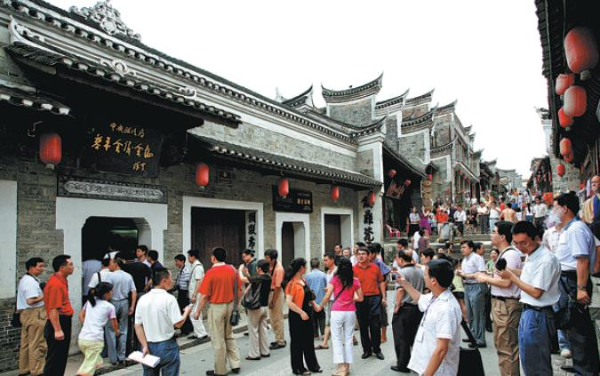Long march tourism boosts heritage protection

Tourists wait to enter the site of the Liping Conference in Liping county, Guizhou. [Photo by Feng Jiaxing / For China Daily]
Cultural park planned
In 2019, the government announced plans to build a national cultural park covering the route of the Long March in memory of the maneuver carried out by the Red Army and led by the CPC against the ruling Kuomintang regime.
The park will spread across 15 provinces and regions, including Guizhou, Fujian, Jiangxi and Gansu. "The development of a national cultural park will embody the 'Long March spirit' and help people learn things when they relax in the park," said Jiang Jiannong, a professor at South China Normal University in Guangzhou, Guangdong province, and an expert on CPC history. He added that the park could tap great potential in the Red tourism sector.
Guizhou has many sites where Red Army soldiers conducted early revolutionary activities. Of the 88 counties, cities and districts in the province, 68 boast Red tourism resources.
Construction of the park will see Guizhou link Red relics and build classic Red scenic spots and tourism routes.
In particular, Zunyi is one of the most important places, as Mao Zedong reasserted his leadership of the Party at the Zunyi Conference in January 1935. The CPC left the city shortly after the meeting ended.
On February 20 that year, the Red Army crossed the Chishui River for the second time, returned to Guizhou, won the Battle of Loushanguan and retook Zunyi from KMT troops, defeating the enemy's two divisions and eight regiments.
It was the CPC's biggest victory since the start of the Long March.
In recent years, Zunyi has been promoting the sites and relics the Red Army left as high-quality tourist attractions. As the most popular Red tourism spot, the conference site has received more than 4 million visits, according to the local tourism bureau.
In addition to the reconstruction of sites and relics, Zunyi is also promoting the integration of tourism and other industries, including a number of works for film and television that focus on revolutionary history during the Long March.
"The city has scrambled to dig deep into local Red cultural resources to promote the transformation and upgrading of Red tourism to gear up new economic drivers," said Cheng Xiaoqiu, head of the Zunyi bureau of culture, sport and tourism. He noted that the city is also using technology to make Red tours more immersive and interesting. For example, augmented and virtual reality have been introduced to help visitors better understand history through simulated experiences.
The development has totally changed the established tourism model that relies on tour guides for sightseeing and narratives, Cheng said. He added that visitors can also experience immersive activities such as wearing replica army uniforms, laying flowers at memorial parks for martyrs and eating simple meals similar to those given to the soldiers decades ago.
To enhance such experiences, cultural and tourism authorities from Guizhou have launched 10 Red tourism routes centered on the cultural heritage of the Long March and invited tourists to revisit the route, including cycling tours to Liupanshui and a cultural tour of Qiandongnan Miao and Dong autonomous prefecture.
Liping county, another important venue, has rebuilt a large number of cultural relics and historical sites from the Long March era and combined them with the local Dong ethnic culture to develop Red tourism.
On Dec 18, 1934, the Political Bureau of the Communist Party of China Central Committee held a conference in Liping that adopted Mao's ideas.
Their original plan of going north to Xiangxi to join two other Red Army divisions was abandoned, and they established a new base on Guizhou's border with Sichuan province.
This enabled the Red Army to avoid the danger of being encircled by the enemy and paved the way for the Zunyi Conference.

Ministry of Justice of the
People's Republic of China
All rights reserved. Presented by China Daily.
京ICP备13016994号-2


